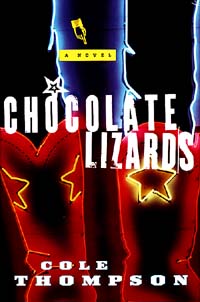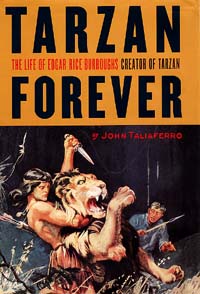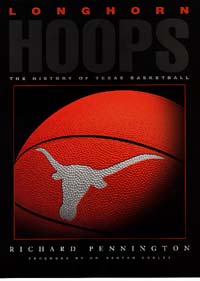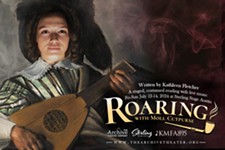Oil's Well That Ends Well
Fri., May 7, 1999
|
|
It's there that he meets well driller Merle Luskey, a rough-hewn gentleman with a streak of bonhomie a mile wide. Merle is a veritable poster boy for political incorrectness, but with a bottomless capacity for kindness. His notion of courtesy encompasses offering the downhearted stranger a shot from his whiskey flask with the greeting, "Lil hair fer yer monkey?"
But Merle's drilling business has fallen on hard times and he's gone to war with the local bank that is trying to foreclose on his loans and repossess his rigs. Lacking alternatives, Erwin (who Merle dubs "Harvard" after his school in "New Anglin'") allows himself to be dragooned into Merle's army as a roughneck on a rig. He is immediately promoted to "ratkiller" -- Merle's Sancho Panza in the quest to keep alive his lifelong dream to be a driller of wells in Abilene, Texas.
Merle's scheme is simplicity itself: Drill a gusher and pay off the bank. But he's got no time, no experience finding oil, and no geological surveys to point him in the right direction. Unfazed by the challenge, he and his reluctant Ivy League ratkiller sneak, thieve, spy, and coerce their way into an oil lease that they hope will do the trick. Along the way, Merle enlists Tex-Ann, a busty and blustery exotic dancer, to entice a reluctant landowner into signing the drilling lease. Merle falls for her like the proverbial ton of bricks, and before long she's buying furniture for the house and making plans to be Wife #5.
Our misplaced Yankee might narrate the tale, but he's only a comic foil -- this is Merle's book through and through. He inhabits it like a circus bear at a cocktail party, swilling Jack Daniels and lurching about with a single-minded determination and boundless optimism and love for life.
Thompson has done his time around oil rigs and he captures that world neatly and accurately and with obvious affection. His rendition of Abilene diction and drawl is hilarious and right on target. Unfortunately, he paints with a broad brush and his characters tend toward stereotype -- the local lawman whose venality is exceeded only by his incompetence and the black-hearted banker come to foreclose on the family farm. But if you turn the stereotypes down a notch or two, you realize you've met most of these people before and, hey, that dirtclod banker might have even turned you down for a loan.
Chocolate Lizards is a homestyle burlesque that evokes a keen sense of time and place. Thompson's over-the-top storytelling doesn't crumble under the weight of its own excess -- it's built on firm underpinnings. There is a place in the Texas canon for Merle Luskey and Chocolate Lizards -- irreverent, indomitable, and inevitable as the sunset burning red through the Abilene dust clouds. --Mike Shea
|
|
Pilkington has developed a reputation in the state as one of the best-known critics of Texas letters, and this book collects and updates essays that were published mainly in the 1980s. His broad knowledge of Texas literature and culture makes his opinions persuasive. Pilkington, university scholar and professor of English at Tarleton State University, reviews books regularly for The Dallas Morning News and The Houston Chronicle and wrote an important early book after the 1960s renaissance in regional literature, My Blood's Country: Studies in Southwestern Literature (1973).
Much of this book examines a question that may seem irrelevant now: Will there ever be a Texas literature commensurate with its myth? To answer this question, Pilkington traces Texas literature from Alvar Nuñez Cabeza de Vaca to J. Frank Dobie, Katherine Anne Porter, George Sessions Perry, Billy Lee Brammer, Elmer Kelton, Cormac McCarthy, and especially Larry McMurtry. The organization is primarily chronological, with the first chapter on the "Ancestors" Cabeza de Vaca and Dobie and the last on "Future Shock: Texas Writing Today and Tomorrow." Other chapters deal with the frontier, ranching, farming, the Southern tradition, the Texas military tradition, and violence in Texas fiction. There's a Hail Mary, long-touchdown pass of a chapter on football in Texas literature and culture. Pilkington finds The Hundred-Yard's War by Gary Cartwright "a sprawling train wreck of a novel" and Semi-Tough by Dan Jenkins "semi-fluff," but he resurrects Douglas Terry's The Last Texas Hero from the dung heap of lost novels and deems North Dallas Forty by Pete Gent "the best of all Texas novels about professional football."
Among the most effective parts of the collection are Pilkington's examinations of his own experiences growing up in the 1940s and 1950s near Mansfield in Tarrant County. Pilkington recounts hearing "whispered rumors about a strange man living on a farm outside town." That strange man was John Howard Griffin, who chemically darkened his skin, traveled the South as a black man in the 1950s, and wrote about it in Black Like Me, a book that laid bare the raw issue of race. Pilkington writes that he "would like to report that I stood up in 1956 and spoke out for decency and justice." But he acknowledges truthfully that as an adolescent he was as confused by the issues as others were and watched as the experience rent the fabric of the community.
One of the most interesting and curious aspects of this book concerns Pilkington's analyses of Larry McMurtry's works. The chapter titled "Doing Without: Larry McMurtry's Thalia Trilogy," originally published in Clay Reynolds' anthology Taking Stock, provides some of the clearest discussion available of McMurtry's first three novels. For many years while critics praised the three early novels highly, McMurtry disparaged them as juvenile, sentimental, overedited, or poorly realized. And yet Pilkington notes that they marked a radical change in Texas letters: "Despite their nostalgia and sentimentality, despite the fact that their creator would apparently disown them if he could, they continue, as we bring the twentieth century to an end and confront a world far removed even from the one sketched in the novels, to speak to readers in a strong and passionate voice." After this clear-eyed discussion, Pilkington seems to have despaired at McMurtry's work, later calling him the "Tonya Harding of Texas Letters" for his attacks on the paucity of Texas literature. Pilkington mentions Lonesome Dove positively and uses Anything for Billy to discuss violence, but he ignores almost all of McMurtry's novels of the 1990s and never recognizes that McMurtry might be capable of producing a late, powerful book like Duane's Depressed.
There're other areas that could be stronger as well. It seems jarring to read through almost the entire collection before arriving at a discussion of Cormac McCarthy except for an early parenthetical mention. The Crossing and Cities of the Plain, the other two books in McCarthy's border trilogy, for many among the most important books in recent Texas literature, appear only in a footnote. It is also somewhat jarring to have a fairly lengthy discussion of Norman Mailer's Texas characters in a chapter called "The Military Experience in Texas Letters" since it breaks the logic of analyzing works by Texas writers. Almost all of Pilkington's longer examinations are of books by Texas writers, except for the Mailer discussion. It would be more logical to use Mailer to highlight the work of a Texas writer such as Robert Flynn, who wrote a World War II novel, The Sounds of Rescue, The Signs of Hope, numerous stories, and a memoir about Vietnam.
Not every writer can possibly be mentioned or evaluated in such a book, but some names missing-in-action seem to stand out, names such as Carolyn Osborn, Sarah Bird, Rick Bass, Mary Karr, Joe Lansdale, and Clay Reynolds. Pilkington also is most comfortable with fiction, rarely mentioning poets or dramatists. Walt McDonald, the dean of Texas poetry, who has written extensively about Vietnam, is absent from these pages. The discussion of Mexican-American literature seems something of an afterthought, coming as it does at the end in a summing-up section of the book.
These quibbles don't diminish the book's importance. Pilkington's careful and career-long observations about the Texas literary scene prove the primary strength of the work. He has read widely, not just in regional literature, as his references to Mailer, Don DeLillo, Faulkner, and Hemingway indicate. Anyone who wants to understand the intricate relationship between Texas literature and culture will need to read State of Mind and prepare for the next fusillade of essays on Texas. -- Mark Busby
Mark Busby is the Director of the Center for the Study of the Southwest at Southwest Texas State University.
|
|
He wasn't. When Tarzan of the Apes was published in 1912, the former pencil-sharpener salesman from Chicago became a 36-year-old overnight sensation. When he died in 1950, Burroughs was the most widely read American author of the century. How then did Tarzan become so internationally recognized?
According to the book, not merely because Burroughs was a clever storyteller incorporating "stupendous action," but because every culture has a "wild child" story -- from the Roman legend of Romulus and Remus to Kipling's Mowgli.
The arrival of any new Tarzan tale was hotly anticipated. According to Taliaferro, Tarzan became immensely popular due in large part to Burrough's shrewd use of what is now known as media synergy. Decades before it would become commonplace, Burroughs negotiated serialization rights, movies, a Tarzan comic strip, dolls, and fan clubs.
As Taliaferro demonstrated in a previous biography of cowboy painter Charles M. Russell, he really enjoys his homework. In Tarzan Forever, he implies that Burroughs had impeccable timing, tapping as he did the burning issue of the post-Victorian era -- heredity versus environment.
A large revelation: Burroughs was enamored with eugenics, a Darwinian fringe movement dedicated to improving humanity through selective breeding. But eugenics begat selective immigration laws and led ultimately to genocide. Although Burroughs would later change his views on eugenics, he once wrote a column for the L.A. Examiner calling for the extermination of all "moral imbeciles." To any Tarzan reader armed with this knowledge, Nature and Nurture intermingle in the novels much more intriguingly. (After all, Tarzan himself is the son of English nobility, possessing a superior bloodline despite dwelling among animals and "jabbering natives.")
And Burroughs was prolific. Constantly seeking new adventures for his international pop-culture icon, Burroughs completed many of his 70-plus novels in a matter of weeks, sometimes writing an astounding 400,000 words per year. Although the quality of these tales often varied wildly, the action never ceased. In most plotlines, Tarzan and/or Jane Porter would encounter secret tribes or races, such as "The Leopard Men" or a lost band of English crusaders sent to liberate the Holy Land. The print version of Tarzan more often reflects the classical education of his creator; in one of countless specific examples from the novels, Tarzan learns Latin in three weeks so as to communicate with the leaders of a lost Roman empire.
"I am always late to the thrill," Burroughs once said of his own life. "I always get to the fire after it is out." He was accepted to West Point but failed the entrance exam, and didn't set foot in Africa until well after the Tarzan books were bestsellers. He was a witness at Pearl Harbor, and failed twice in marriage. He was a cavalryman in the Arizona Territory, was the oldest American war correspondent in the South Pacific, and spent enough of his fortune to force himself to have to develop his beloved ranch, Tarzana, into what is today a Los Angeles suburb.
But he lived a colorful life sparked by a prodigious imagination. Although Burroughs would try his writing hand at other genres (Mars sci-fi was a particular fascination), he always returned to young lord Greystoke. The Tarzan books endure, even though Tarzan lives on mainly in Disney's pantheon, and most people think of Burrough's noble savage as the loin-clothed, monosyllabic oaf Hollywood made him out to be. John Taliaferro's entertaining book shows in rich detail why this misperception is indeed a pity. --Stuart Wade
|
|
Riots in Watts had broken out for the second time. The Black Panthers had been formed, George Wallace was running for the White House, pledging continued segregation, and Stokely Carmichael began using the term "Black Power."
In the midst of that conflict occurred what may have been the most important collegiate sporting event ever: the NCAA championship basketball game between the all-white Kentucky University Wildcats and the Texas Western College Miners, a team that started five black players. The game has been written about many times, but Frank Fitzpatrick's book, And the Walls Came Tumbling Down: Kentucky, Texas Western,and the Game That Changed American Sports, puts the game in context. He describes the segregated South and how Texas Western, now known as the University of Texas-El Paso, was able to recruit black players while other Texas schools could not. And Fitzpatrick does it with colorful writing. Here's his description of the late Kentucky Coach Adolph Rupp: "His suits were always brown, his pajamas always red and his teams, with only two exceptions in forty-two years, always white." Fitzpatrick describes Texas Western coach Don Haskins (who is still alive and still coaching at UTEP) thusly: "He fussed and fidgeted so badly that friends had difficulty imagining him asleep. 'Tarzan with his loincloth on fire,'" is how one associate described him. Texas Western went on to beat Kentucky 72-65.
While Fitzpatrick focuses on the significance of one game, Richard Pennington, in his voluminous coffeetable book, Longhorn Hoops: The History of Texas Basketball, records the impact of nearly 3,000 matchups. The book spans a couple of lifetimes' worth of basketball, beginning with the first University of Texas men's game in 1906, when 100 fans turned out to see the Longhorns beat Baylor 27-17, to last year's hiring of Rick Barnes. Each year includes a complete list of games and scores, including this record from 1909: Texas, 39, Deaf and Dumb Institute, 9. For the women, the history spans from the early, non-competitive years through the Anna Hiss years in the mid-Fifties and ends in 1998, a year in which the Lady Longhorns endured a 12-15 record.
|
|
The story of women's basketball at UT is largely the story of Jody Conradt, who came to Austin in 1977, just two years after the sport gained varsity status. Given that UT provided funding for the book, it's not too surprising that Pennington is not overly critical of Conradt, or that he doesn't discuss the program's reputation as being a "homosexual program." Pennington does mention, though, the 1994 series that the local daily did on Conradt's program. Pennington shines while discussing Anna Hiss. The sister of alleged spy Alger Hiss, she spent four decades on the UT campus as director of physical education for women and as Pennington writes, she was "dead-set against intercollegiate athletics for women."
From 1918 to 1957, Hiss made sure women participated in sports, but didn't actually compete. For that reason, the Hiss Gym on the Forty Acres, arguably the most beautiful building on campus, contains basketball courts that are too small to be used for competition. The swimming pool, torn down to make way for the molecular biology building, was built just short of Olympic length for the same reason.
Both of these books are fascinating historical records. If you are a nut for UT basketball, get Pennington's book. If you are nuts about hoops
in general, or want to know more about race relations in America, read Fitzpatrick's book. You won't be disappointed in either one.--Robert Bryce











